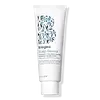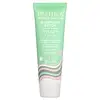What's inside
What's inside
 Key Ingredients
Key Ingredients

 Benefits
Benefits

 Concerns
Concerns

 Ingredients Side-by-side
Ingredients Side-by-side

Water
Skin ConditioningCaprylic/Capric Triglyceride
MaskingHydroxypropyl Starch Phosphate
Cetearyl Alcohol
EmollientGlyceryl Stearate
EmollientBrassica Alcohol
EmollientPropanediol
SolventGlycerin
HumectantCetyl Alcohol
EmollientCocos Nucifera Oil
MaskingCharcoal Powder
AbrasiveAloe Barbadensis Leaf Juice
Skin ConditioningMelaleuca Alternifolia Leaf Oil
AntioxidantBiotin
AntiseborrhoeicMentha Piperita Oil
MaskingMentha Viridis Leaf Oil
AstringentSodium Hyaluronate
HumectantNiacinamide
SmoothingBrassicyl Valinate Esylate
EmollientCarrageenan
Arginine
MaskingPanthenol
Skin ConditioningCetyl Hydroxyethylcellulose
Emulsion StabilisingCitric Acid
BufferingSodium PCA
HumectantGuar Hydroxypropyltrimonium Chloride
Skin ConditioningMenthyl Lactate
MaskingPlantago Lanceolata Leaf Extract
AntimicrobialPotassium Hydroxide
BufferingCalcium Gluconate
HumectantPotassium Sorbate
PreservativeSodium Benzoate
MaskingSodium Metabisulfite
AntioxidantTetrasodium Glutamate Diacetate
Sodium Glycolate
BufferingSodium Formate
BufferingSodium Hydroxide
BufferingChlorphenesin
AntimicrobialDehydroacetic Acid
PreservativeBenzyl Alcohol
PerfumingLimonene
PerfumingWater, Caprylic/Capric Triglyceride, Hydroxypropyl Starch Phosphate, Cetearyl Alcohol, Glyceryl Stearate, Brassica Alcohol, Propanediol, Glycerin, Cetyl Alcohol, Cocos Nucifera Oil, Charcoal Powder, Aloe Barbadensis Leaf Juice, Melaleuca Alternifolia Leaf Oil, Biotin, Mentha Piperita Oil, Mentha Viridis Leaf Oil, Sodium Hyaluronate, Niacinamide, Brassicyl Valinate Esylate, Carrageenan, Arginine, Panthenol, Cetyl Hydroxyethylcellulose, Citric Acid, Sodium PCA, Guar Hydroxypropyltrimonium Chloride, Menthyl Lactate, Plantago Lanceolata Leaf Extract, Potassium Hydroxide, Calcium Gluconate, Potassium Sorbate, Sodium Benzoate, Sodium Metabisulfite, Tetrasodium Glutamate Diacetate, Sodium Glycolate, Sodium Formate, Sodium Hydroxide, Chlorphenesin, Dehydroacetic Acid, Benzyl Alcohol, Limonene
Sea Salt
AbrasiveCocamidopropyl Hydroxysultaine
CleansingGlycerin
HumectantSucrose
HumectantGlyceryl Caprylate/Caprate
EmollientSodium Methyl Cocoyl Taurate
CleansingSodium Cocoyl Isethionate
CleansingJojoba Esters
EmollientCharcoal Powder
AbrasiveRosmarinus Officinalis Leaf Extract
AntimicrobialLavandula Angustifolia Flower Extract
CleansingRosa Moschata Seed Oil
EmollientMentha Piperita Oil
MaskingMenthol
MaskingMelaleuca Alternifolia Leaf Oil
AntioxidantGlyceryl Stearate Se
EmulsifyingLactococcus Ferment Lysate
Skin ConditioningOryza Sativa Bran Extract
Skin ConditioningHelianthus Annuus Extract
EmollientTocopherol
AntioxidantSodium Benzoate
MaskingPotassium Sorbate
PreservativeSodium Gluconate
Skin ConditioningIron Oxides
Citric Acid
BufferingParfum
MaskingSea Salt, Cocamidopropyl Hydroxysultaine, Glycerin, Sucrose, Glyceryl Caprylate/Caprate, Sodium Methyl Cocoyl Taurate, Sodium Cocoyl Isethionate, Jojoba Esters, Charcoal Powder, Rosmarinus Officinalis Leaf Extract, Lavandula Angustifolia Flower Extract, Rosa Moschata Seed Oil, Mentha Piperita Oil, Menthol, Melaleuca Alternifolia Leaf Oil, Glyceryl Stearate Se, Lactococcus Ferment Lysate, Oryza Sativa Bran Extract, Helianthus Annuus Extract, Tocopherol, Sodium Benzoate, Potassium Sorbate, Sodium Gluconate, Iron Oxides, Citric Acid, Parfum
 Reviews
Reviews

Ingredients Explained
These ingredients are found in both products.
Ingredients higher up in an ingredient list are typically present in a larger amount.
Charcoal powder comes from grounded charcoal. Charcoal can originate from peat, bamboo, coal, wood, coconut shell, or petroleum.
This ingredient has absorbent properties, making it great at absorbing oil.
Citric Acid is an alpha hydroxy acid (AHA) naturally found in citrus fruits like oranges, lemons, and limes.
Like other AHAs, citric acid can exfoliate skin by breaking down the bonds that hold dead skin cells together. This helps reveal smoother and brighter skin underneath.
However, this exfoliating effect only happens at high concentrations (20%) which can be hard to find in cosmetic products.
Due to this, citric acid is usually included in small amounts as a pH adjuster. This helps keep products slightly more acidic and compatible with skin's natural pH.
In skincare formulas, citric acid can:
While it can provide some skin benefits, research shows lactic acid and glycolic acid are generally more effective and less irritating exfoliants.
Most citric acid used in skincare today is made by fermenting sugars (usually from molasses). This synthetic version is identical to the natural citrus form but easier to stabilize and use in formulations.
Read more about some other popular AHA's here:
Learn more about Citric AcidGlycerin is already naturally found in your skin. It helps moisturize and protect your skin.
A study from 2016 found glycerin to be more effective as a humectant than AHAs and hyaluronic acid.
As a humectant, it helps the skin stay hydrated by pulling moisture to your skin. The low molecular weight of glycerin allows it to pull moisture into the deeper layers of your skin.
Hydrated skin improves your skin barrier; Your skin barrier helps protect against irritants and bacteria.
Glycerin has also been found to have antimicrobial and antiviral properties. Due to these properties, glycerin is often used in wound and burn treatments.
In cosmetics, glycerin is usually derived from plants such as soybean or palm. However, it can also be sourced from animals, such as tallow or animal fat.
This ingredient is organic, colorless, odorless, and non-toxic.
Glycerin is the name for this ingredient in American English. British English uses Glycerol/Glycerine.
Learn more about GlycerinThis tea tree oil comes from the leaves of the Tea Tree plant. Tea tree oil has antioxidant, anti-inflammatory, and antimicrobial properties.
According to the book Journal of Profiles of Drug Substances, tea tree helps in reducing acne-causing bacteria such as Propionibacterium acnes. This is due to the Terpinen components of tea tree oil.
Tea tree may cause sensitivity and irritation for some people. This oil naturally contains fragrance such as linalool and limonene.
However, research shows irritation usually occurs when using pure tea tree oil and not in cosmetic products.
Tea tree oil was found to help relieve the symptoms of psoriasis in one study.
Tea tree oil is toxic when ingested. Another study showed it to caused damage to the nervous system of dogs and cats when applied to their skin or given orally.
Learn more about Melaleuca Alternifolia Leaf OilMentha Piperita Oil is the volatile oil obtained from the whole plant of the Peppermint plant.
It can be used to add a fresh scent to products.
Peppermint oil may cause skin sensitivity and redness due to its menthol content. Menthol also has a cooling effect (like your toothpaste).
Learn more about Mentha Piperita OilPotassium Sorbate is a preservative used to prevent yeast and mold in products. It is commonly found in both cosmetic and food products.
This ingredient comes from potassium salt derived from sorbic acid. Sorbic acid is a natural antibiotic and effective against fungus.
Both potassium sorbate and sorbic acid can be found in baked goods, cheeses, dried meats, dried fruit, ice cream, pickles, wine, yogurt, and more.
You'll often find this ingredient used with other preservatives.
Learn more about Potassium SorbateSodium Benzoate is a preservative. It's used in both cosmetic and food products to inhibit the growth of mold and bacteria. It is typically produced synthetically.
Both the US FDA and EU Health Committee have approved the use of sodium benzoate. In the US, levels of 0.1% (of the total product) are allowed.
Sodium benzoate works as a preservative by inhibiting the growth of bacteria inside of cells. It prevents the cell from fermenting a type of sugar using an enzyme called phosphofructokinase.
It is the salt of benzoic acid. Foods containing sodium benzoate include soda, salad dressings, condiments, fruit juices, wines, and snack foods.
Studies for using ascorbic acid and sodium benzoate in cosmetics are lacking, especially in skincare routines with multiple steps.
We always recommend speaking with a professional, such as a dermatologist, if you have any concerns.
Learn more about Sodium Benzoate